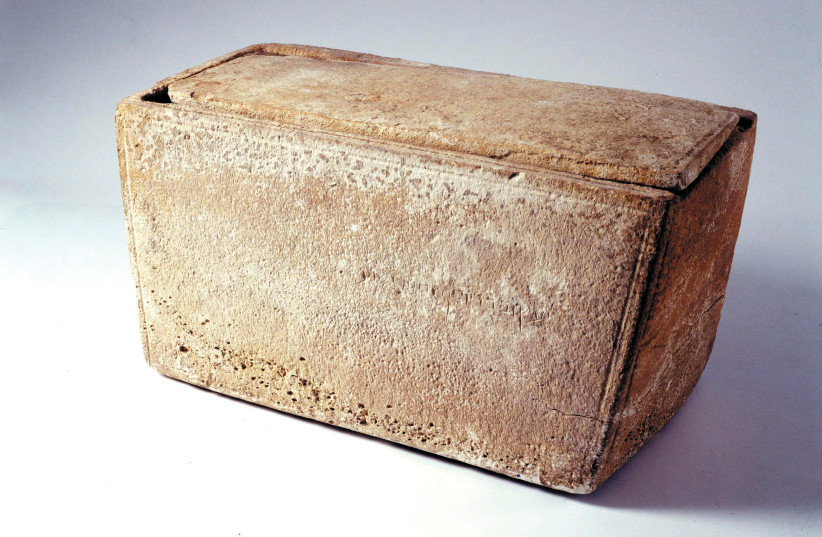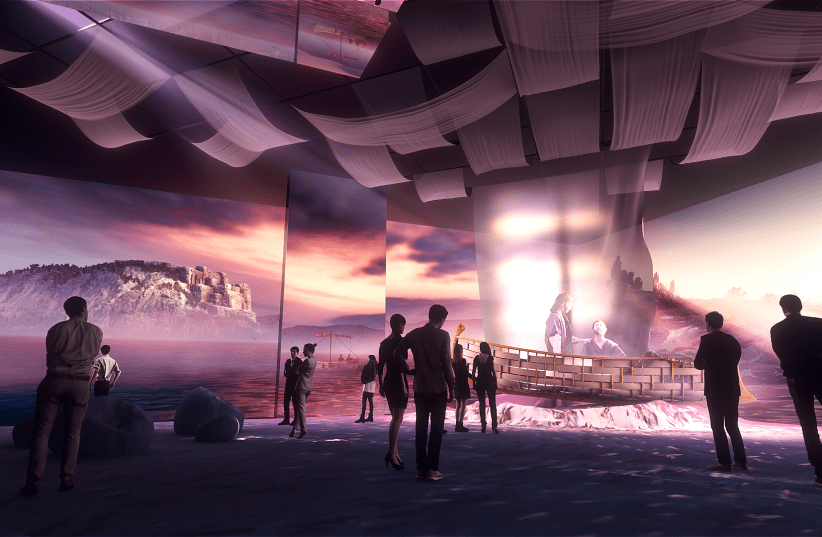
How much will Bible Belt evangelists pay to get up close and personal with the 1st-century ossuary inscribed in Aramaic “Jacob (James), son of Joseph, brother of Jesus”?
AlpineArtists.com, the shadowy entrepreneur organizing the blockbuster exhibition “The Nazarene – The Way, The Truth, and The Life,” is touting the 2,000-year-old limestone bone box and its lid as the oldest artifact attesting to the life of the Christian messiah. Tickets to view the relic and 300 associated artifacts found in archaeological digs across Israel – on display in Dallas from August 25 to October 15 – are $69 (free for children age 4 and under).
Scholars caution that the James Ossuary, measuring 50.5 by 25 by 30.5 centimeters (19.9 in × 9.8 in × 12.0), may be an elaborate 20th-century hoax and epigraphic forgery whose final words were chiseled out on a genuine ossuary some two millennia after the original inscription.
What will the glitzy multi-media extravaganza and the related “Discovering Jesus” exhibit entail?
A press release from AlpineArtists.com gushes: “You will enter the holy lands of Galilee and Israel. Feel the hot air of the Judean Desert and the cool breeze of the Jordan River. Witness miracles and betrayals…. We will open a window in time as you travel back to experience the events of 2,000 years ago.”
It continues: “Tickets are on sale now at TheNazareneXP.com, and customers can reserve their date and time to experience this multi-sensory journey of biblical proportions that the entire family will enjoy.”


“‘The Nazarene’ is not just an exhibition but a spiritual journey and a testimony of faith woven from innovative threads and meticulous designs to unfold in a way that the world has not yet seen,” promised Alpine Artists’ executive producer Robert Bagdasarov.
“This groundbreaking technological experience will create a sense of time travel for our guests and bring them closer to the story of Jesus.”
For those whose faith is strong but are seeking proof, the pricey admission will be a bargain. At the 2,900 sq m (30,000 sq ft) exhibit, they will view the stone coffin that may have held the bones of the first bishop of Jerusalem and who may have been Jesus’s stepbrother from a previous marriage of their father, Joseph.
While the 2,000-year-old ossuary is seemingly genuine, the underlying issue is whether its paleo-Hebrew inscription is the real deal. Or a clever fake replete with ersatz patina that was planted to fool experts.
Nothing is known of the James Ossuary’s provenance, as is the case with looted artifacts traded on Israel’s quasi-legal antiquities market.
Joe Zias, a retired physical anthropologist in Jerusalem who spent decades working for the Israel Antiquities Authority, reportedly saw the ossuary at an antiquities shop on the Via Dolorosa in Jerusalem’s Old City in the 1990s. The inscription then read simply “Jacob (James) son of Joseph,” he claimed.
A decade later the nondescript ossuary, purchased by controversial Tel Aviv antiquities dealer Oded Golan, resurfaced. Its famous inscription echoes Mark 6:3 that records Jesus was the brother of James, Joses, Judas and Simon, as well as the sibling of some unnamed sisters. The ossuary’s existence was bombastically announced at an October 21, 2002, press conference in Washington, DC, co-hosted by the Discovery Channel and the Biblical Archaeology Society, the non-sectarian publisher of the Biblical Archaeology Review, which seeks to popularize archaeological and academic research related to the Hebrew Bible and the New Testament.
The inscription on Golan’s ossuary was initially translated by André Lemaire, a respected Semitic epigrapher at the Sorbonne University’s prestigious École pratique des hautes études in Paris. The professor’s analysis claiming that the ossuary and its inscription were authentic was published in BAR’s November/ December 2002 issue.
Lamarie’s credibility, however, suffered a blow when he authenticated the so-called “ivory pomegranate,” alleged to be a 2,800-year-old cult object from Solomon’s Temple on Mount Moriah, leading to its purchase by the Israel Museum in Jerusalem for $550,000. In 2004, other scholars disputed Lamaire’s view, alleging the object was part of an elaborate antiquities fraud involving several suspected high-profile archaeological forgeries. Another was the Jehoash Inscription.
Following a major investigation by the Israel Antiquities Authority (IAA), a commission of experts, which included Prof. Yuval Goren of Tel Aviv University, determined that Golan’s artifact dated back to the 14th or 13th century BCE but that the latter half of its inscription was a modern forgery.
In December 2004, the scandal led to Golan being arrested and charged with 44 counts of forgery, fraud, and deception, including forgery of the ossuary inscription. This marked the first time a criminal court had been asked to rule in a case of antiquities forgery. But the bar to legal certainty is a higher bar than archaeologists’ expert opinion. In an external expert report, dated September 2005, Wolfgang E. Krumbein concluded: “Our preliminary investigations cannot prove the authenticity of the three objects beyond any doubt. Doubtlessly, the patina is continuous in many places throughout surface and lettering grooves in the case of ossuary and tablet. On the other hand, a proof of forgery is not given by the experts nominated by the IAA.”
In March 2012, after a seven-year trial, Judge Aharon Farkash issued a 700-page ruling acquitting Golan of the forgery charges but convicting him of the lesser count of illegally trading in antiquities. The judge ruled that Golan’s acquittal “does not mean that the inscription on the ossuary is authentic or that it was written 2,000 years ago. This will continue to be studied by scientists and archaeologists, and time will tell.
“Moreover,” he wrote, “it was not proven in any way that the words ‘the brother of Jesus’ necessarily refer to the ‘Jesus’ who appears in Christian writings.”
The ossuary was finally returned to Golan, who profited handsomely when it was put on public display at the Royal Ontario Museum in Toronto from November 15, 2002, to January 5, 2003. Presumably, the Dallas exhibit will also bring him a fat fee.
The IAA’s failure to explain why it concluded the ossuary is a forgery has not helped the muddied question of veracity. Writing in The Times of Israel, Matti Friedman noted: “The failure of a high-profile prosecution for antiquities fraud perpetuates the mystery of a find hailed as physical proof that Jesus existed.”
“The trial was a collision of two worlds — criminal prosecution and scholarly archaeology,” said journalist Matthew Kalman, a former editor of The Jerusalem Report and the only reporter to cover the entire trial.
“The two simply speak different languages,” he said. “The verdict will not make a difference to the archaeologists arguing about whether the artifacts are authentic.”
Known as James the Lesser or the Just to distinguish him from James the Great, son of Zebedee, who was one of Jesus’s 12 apostles, Jesus’s half-brother James is believed to have been martyred in Jerusalem in 62 or 69 CE. He was stoned to death by the Pharisees on the order of high priest Ananus ben Anunus.
At that point, in keeping with Jewish funerary practices of the time called ossilegium, James’s corpse was placed on a ledge in a rock-hewn sepulcher, his body covered with lime, and then the cave was sealed. After a year, during which the flesh rotted away, the rolling stone sealing the grave was pushed aside, and the skeleton was placed in an ossuary. The box is slightly smaller than average compared to other ossuaries of the time. It fits the femur – the longest human bone – and the skull – the widest. After an inscription was hastily marked on the soft limestone, the ossuary was placed with others as one was gathered unto one’s fathers.
The Jewish community in and around Jerusalem practiced this form of burial from about 20 BCE until the destruction of the city in 70 CE. The custom continued outside of Jerusalem and in Judea until as late as the middle of the third century.
“‘The Nazarene’ is approximately a one-hour experience,” said Alpine Artists. “If you are viewing the artifact exhibit as well, plan to stay for an additional 30 minutes. And don’t forget to allow time to browse the gift shop.”
John Tellem of Tellem Grody PR, which is handling publicity for Dallas’s “The Nazarene,” declined to comment. ■
